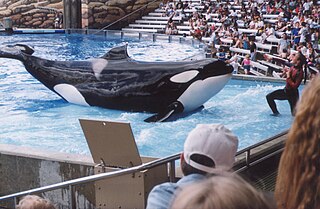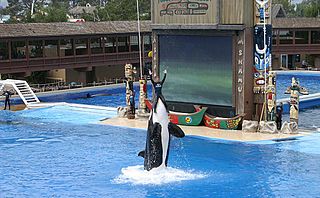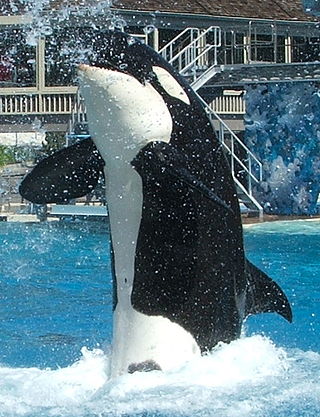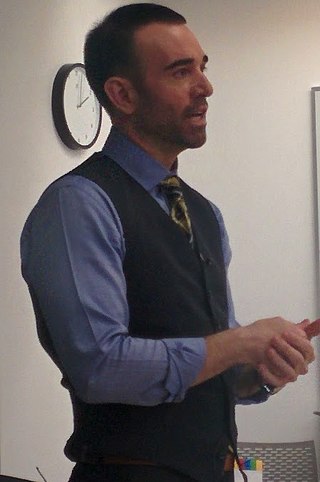
SeaWorld is an American theme park chain with headquarters in Orlando, Florida. It is a proprietor of marine mammal parks, oceanariums, animal theme parks, and rehabilitation centers owned by United Parks & Resorts. The parks feature orcas, sea lion, and dolphin shows and zoological displays featuring various other marine animals.

Corky II, often referred to as just Corky, is a female captive orca from the A5 Pod of northern resident orcas. At approximately the age of four, Corky was captured from Pender Harbour off the coast of British Columbia on December 11, 1969. She has lived at SeaWorld San Diego in San Diego, California since 1987. As of 2023, she is the oldest and longest kept captive orca. SeaWorld San Diego celebrates her birthday on 2 January every year.
Shamu was a female orca captured in October 1965 from a southern resident pod. She was sold to SeaWorld San Diego and became a star attraction. Shamu was the fourth orca ever captured, and the second female. She died in August 1971, after about six years of captivity. After her death, the name Shamu continued to be used in SeaWorld "Shamu" shows for different orcas in different SeaWorld parks.

Katina is a female orca who lives at SeaWorld Orlando in Florida. She was captured off Iceland at approximately three years of age on October 26, 1978. She is the most successful breeding female orca in captivity.

Kasatka was a wild caught female orca who lived at SeaWorld San Diego.
Ramu III was an Orca who resided at the now-defunct Windsor Safari Park in Berkshire, England between 1970 and 1976, and later, at SeaWorld San Diego in California between 1976 and 1986. An adult male, Ramu was caught on August 8, 1970, after his pod of eighty orcas was 'corralled' during the Penn Cove capture in Penn Cove, near Coupeville, Washington, United States. At capture, Ramu was 13.32 ft long and a member of the Southern Resident Killer Whales' L-pod. It is assumed his family members still survive in the Salish Sea and in nearby Pacific coastal waters.

SeaWorld Orlando is an animal theme park located in Orlando, Florida. Although separately gated, it is often promoted with neighboring parks Discovery Cove and Aquatica as well as Busch Gardens Tampa Bay, all of which are owned and operated by United Parks & Resorts. In 2022, SeaWorld Orlando hosted an estimated 4.45 million guests, ranking it the 10th most visited amusement park in the United States.

A marine mammal park is a commercial theme park or aquarium where marine mammals such as dolphins, beluga whales and sea lions are kept within water tanks and displayed to the public in special shows. A marine mammal park is more elaborate than a dolphinarium, because it also features other marine mammals and offers additional entertainment attractions. It is thus seen as a combination of a public aquarium and an amusement park. Marine mammal parks are different from marine parks, which include natural reserves and marine wildlife sanctuaries such as coral reefs, particularly in Australia.

Mundo Marino is the largest aquarium in Argentina. It is located in San Clemente del Tuyú, Argentina.
Orcas are large, powerful aquatic apex predators. There have been multiple orca attacks on humans in the wild, but such attacks are less common than those by captive orcas. In captivity, there have been several non-fatal and four fatal attacks on humans since the 1970s. Experts are divided as to whether the injuries and deaths were accidental or deliberate attempts to cause harm.

Dozens of orcas are held in captivity for breeding or performance purposes. The practice of capturing and displaying orcas in exhibitions began in the 1960s, and they soon became popular attractions at public aquariums and aquatic theme parks due to their intelligence, trainability, striking appearance, playfulness, and sheer size. As of 1 January 2024, around 59 orcas are in captivity worldwide, 35 of which were captive-born. At that time, there were 18 orcas in the SeaWorld parks.

Dawn Therese Brancheau was an American animal trainer at SeaWorld. She worked with orcas at SeaWorld Orlando for fifteen years, including a leading role in revamping the Shamu show, and was SeaWorld's poster girl. She was killed by an orca, Tilikum, who was also involved in the deaths of Keltie Byrne and Daniel P. Dukes.

Tilikum, nicknamed Tilly, was a captive male orca who spent most of his life at SeaWorld Orlando in Florida. He was captured in Iceland in 1983; about a year later, he was transferred to Sealand of the Pacific near Victoria, British Columbia, Canada. He was subsequently transferred in 1992 to SeaWorld in Orlando, Florida, where he sired 21 calves throughout his life.

Ulises is a male orca who lives at SeaWorld San Diego in California. He was captured off the coast of Iceland in 1980 and is currently the oldest male orca in captivity as of 2022. SeaWorld San Diego celebrates his birthday on 1st January every year.

Blackfish is a 2013 American documentary film directed by Gabriela Cowperthwaite. It concerns Tilikum, an orca held by SeaWorld and the controversy over captive orcas. The film premiered at the 2013 Sundance Film Festival on January 19, 2013, and was picked up by Magnolia Pictures and CNN Films for wider release. It was nominated for the BAFTA Award for Best Documentary.

Tilikum v. Sea World was a legal case heard in the US Federal Court in 2012 concerning the constitutional standing of an orca. It was brought by People for the Ethical Treatment of Animals (PETA) on behalf of Tilikum, an orca kept in the SeaWorld Orlando park, against the SeaWorld corporation.

John Hargrove is a former senior killer whale trainer for SeaWorld and supervisor of killer whale training at Marineland of Antibes in France. Hargrove appeared in the 2013 documentary Blackfish, wrote a book about his experiences in Beneath the Surface, and has campaigned in support of legislation in California and New York to end the practice of keeping killer whales in captivity.
Alexis Martínez was a Spanish animal trainer, notable as the victim of a fatal attack by an orca. He was killed by a SeaWorld-owned orca, Keto, held at Loro Parque's Orca Ocean in the Canary Islands.
Walter the Whale (Skana) was a star orca (killer whale) during the early era of captive orcas in the 1960s. In 1967, following the death of Namu, the only other established star orca was Shamu. Walter the Whale was the orca's advertised name at first, but she was later renamed Skana.















